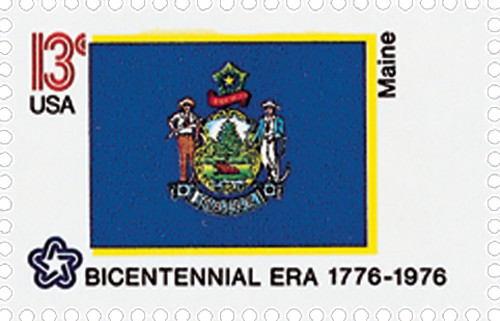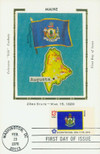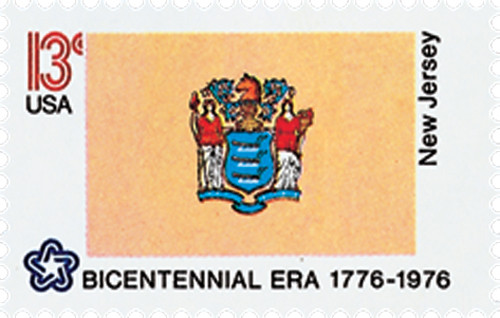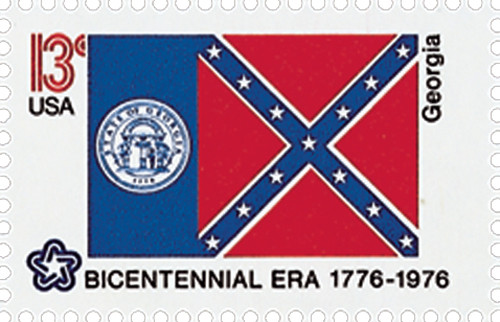
# 1655 - 1976 13c State Flags: Maine
U.S. 1655
1976 Maine
State Flags
American Bicentennial Series
• First time a sheet 50 had all different stamp designs
• Part of the American Bicentennial Series
Stamp Category: Commemorative
Series: American Bicentennial Series
Value: 13¢ First-class postage rate
First Day of Issue: February 23, 1976
First Day City(s): Washington, DC
Quantity Issued: 8,720,100 (panes of 50)
Printed by: Bureau of Engraving and Printing
Printing Method: Photogravure
Format: Sheet of 50
Perforations: 11
Why the stamp was issued:
The United States Postal Service celebrated the American Bicentennial with a full pane of the Union’s fifty state flags.
About the stamp design:
Maine's first state flag was adopted in 1901 and pictured a pine tree and polar star on a field of beige. Eight years later, Maine adopted the current state flag, which shows the state seal on a field of blue. Both flags feature the majestic white pine tree.
About the printing process:
Printed by the Bureau of Engraving and Printing on their seven-color Andreotti gravure press (601) which was their work horse for multicolored stamps.
About the American Bicentennial Series:
In the 1970s, America celebrated its 200th anniversary with hundreds of national events commemorating the heroes and historic events that led to our nation’s independence from Great Britain. The U.S. Postal Service issued 113 commemorative stamps over a six-year period in honor of the U.S. bicentennial, beginning with the American Revolution Bicentennial Commission Emblem stamp (U.S. #1432). As a group, the Bicentennial Series chronicles one of our nation’s most important chapters, and remembers the events and patriots who made the U.S. a world model for liberty.
Several of the stamps honored colonial life – craftsmen and communication. Other stamps honored important battles including Lexington and Concord, Bunker Hill, and Saratoga. Significant events such as the Boston Tea Party, the meeting of the First Continental Congress, and the Declaration of Independence were featured as well. The stamps also honored many significant people such as George Washington, Sybil Ludington, Salem Poor, and the Marquis de Lafayette.
Many of the stamps feature classic artwork. For instance, the set of four souvenir sheets picture important events recreated by noted artists such as John Trumbull. The Bicentennial Series also includes an important US postal first – the first 50-stamp se-tenant – featuring all 50 state flags. The format proved to be popular with collectors, and has been repeated many times since.
The American Bicentennial Series is packed with important US history – it tells the story of our nation’s fight for independence through stamps.
History the stamp represents:
On March 15, 1820, Maine became America’s 23rd state.
Before European settlement, thousands of Indians lived in Maine. Most belonged to the Abenaki and Etchemin tribes of the Algonquian Indian family. The Iroquois Indians frequently attacked these people, and they were bitter enemies.
In 1498, John Cabot, an Italian captain in the service of England, reached Maine. France also sent many explorers to the area, including: Giovanni da Verrazzano in 1524; Pierre du Gua de Monts, in 1604; and Samuel de Champlain in 1604. Champlain named Mount Desert, the largest island on the Maine coast.
Two wealthy Englishmen, Sir Ferdinando Gorges and Sir John Popham, sent George Weymouth to explore the coast of Maine. Weymouth’s report encouraged Gorges and Popham to attempt settlement. In 1607, a group of colonists established Popham Colony, near the mouth of the Kennebec River. Popham’s death and troubles with Indians forced the colonists to return to England a year later. Interestingly, during their stay in Maine, the colonists made the first boat built by the English colonists in America, the Virginia.
In 1622, the Council for New England granted Ferdinando Gorges and John Mason a large tract of land that extended through much of present-day Maine and New Hampshire. Perhaps the first permanent English settlement was founded near today’s city of Saco in 1623. Several more English settlements followed. In 1629, Gorges and Mason divided the land, and Gorges took control of Maine. Gorges established Maine’s first government in 1636. In 1642, he chartered the first English city in what is now the United States, Georgeana (now York). By 1658, Maine was made part of the Massachusetts Bay Colony. However, the Gorges family fought for their claim. In 1677, Massachusetts finally took control of the colony by purchasing it from the Gorges family.
Patriots in Maine were involved with protesting British taxation policies before the start of the American Revolutionary War. In 1774, a group of patriots destroyed a shipment of tea at York, in a protest similar to the legendary Boston Tea Party. This incident became known as the York Tea Party.
After the war started in Massachusetts, Maine endured many hardships – especially the people that lived in towns. In 1775, British soldiers burned Falmouth, now Portland, as a punishment for their rebellion. The first naval battle of the war took place off the coast of Maine near Machias in June 1775. That year, Benedict Arnold led troops from Augusta, Maine, to capture Quebec, but Arnold and his troops were badly beaten. In 1779, the British occupied the town of Castine, and patriot efforts to liberate it were defeated.
After the war, Maine’s population increased rapidly. Massachusetts soldiers were rewarded for their service with grants of property in Maine. Also, land was sold at very affordable prices.
The people of Maine became increasingly dissatisfied with the government of Massachusetts. Their list of complaints included high taxes, poor roads, and the great distance to the state capital, Boston. After the War of 1812, a movement for independence gained momentum. Many pro-separation candidates won election to legislature, and their influence swayed many voters. In 1819, the people voted for separation. On March 15, 1820, Maine entered the Union as its 23rd state.
U.S. 1655
1976 Maine
State Flags
American Bicentennial Series
• First time a sheet 50 had all different stamp designs
• Part of the American Bicentennial Series
Stamp Category: Commemorative
Series: American Bicentennial Series
Value: 13¢ First-class postage rate
First Day of Issue: February 23, 1976
First Day City(s): Washington, DC
Quantity Issued: 8,720,100 (panes of 50)
Printed by: Bureau of Engraving and Printing
Printing Method: Photogravure
Format: Sheet of 50
Perforations: 11
Why the stamp was issued:
The United States Postal Service celebrated the American Bicentennial with a full pane of the Union’s fifty state flags.
About the stamp design:
Maine's first state flag was adopted in 1901 and pictured a pine tree and polar star on a field of beige. Eight years later, Maine adopted the current state flag, which shows the state seal on a field of blue. Both flags feature the majestic white pine tree.
About the printing process:
Printed by the Bureau of Engraving and Printing on their seven-color Andreotti gravure press (601) which was their work horse for multicolored stamps.
About the American Bicentennial Series:
In the 1970s, America celebrated its 200th anniversary with hundreds of national events commemorating the heroes and historic events that led to our nation’s independence from Great Britain. The U.S. Postal Service issued 113 commemorative stamps over a six-year period in honor of the U.S. bicentennial, beginning with the American Revolution Bicentennial Commission Emblem stamp (U.S. #1432). As a group, the Bicentennial Series chronicles one of our nation’s most important chapters, and remembers the events and patriots who made the U.S. a world model for liberty.
Several of the stamps honored colonial life – craftsmen and communication. Other stamps honored important battles including Lexington and Concord, Bunker Hill, and Saratoga. Significant events such as the Boston Tea Party, the meeting of the First Continental Congress, and the Declaration of Independence were featured as well. The stamps also honored many significant people such as George Washington, Sybil Ludington, Salem Poor, and the Marquis de Lafayette.
Many of the stamps feature classic artwork. For instance, the set of four souvenir sheets picture important events recreated by noted artists such as John Trumbull. The Bicentennial Series also includes an important US postal first – the first 50-stamp se-tenant – featuring all 50 state flags. The format proved to be popular with collectors, and has been repeated many times since.
The American Bicentennial Series is packed with important US history – it tells the story of our nation’s fight for independence through stamps.
History the stamp represents:
On March 15, 1820, Maine became America’s 23rd state.
Before European settlement, thousands of Indians lived in Maine. Most belonged to the Abenaki and Etchemin tribes of the Algonquian Indian family. The Iroquois Indians frequently attacked these people, and they were bitter enemies.
In 1498, John Cabot, an Italian captain in the service of England, reached Maine. France also sent many explorers to the area, including: Giovanni da Verrazzano in 1524; Pierre du Gua de Monts, in 1604; and Samuel de Champlain in 1604. Champlain named Mount Desert, the largest island on the Maine coast.
Two wealthy Englishmen, Sir Ferdinando Gorges and Sir John Popham, sent George Weymouth to explore the coast of Maine. Weymouth’s report encouraged Gorges and Popham to attempt settlement. In 1607, a group of colonists established Popham Colony, near the mouth of the Kennebec River. Popham’s death and troubles with Indians forced the colonists to return to England a year later. Interestingly, during their stay in Maine, the colonists made the first boat built by the English colonists in America, the Virginia.
In 1622, the Council for New England granted Ferdinando Gorges and John Mason a large tract of land that extended through much of present-day Maine and New Hampshire. Perhaps the first permanent English settlement was founded near today’s city of Saco in 1623. Several more English settlements followed. In 1629, Gorges and Mason divided the land, and Gorges took control of Maine. Gorges established Maine’s first government in 1636. In 1642, he chartered the first English city in what is now the United States, Georgeana (now York). By 1658, Maine was made part of the Massachusetts Bay Colony. However, the Gorges family fought for their claim. In 1677, Massachusetts finally took control of the colony by purchasing it from the Gorges family.
Patriots in Maine were involved with protesting British taxation policies before the start of the American Revolutionary War. In 1774, a group of patriots destroyed a shipment of tea at York, in a protest similar to the legendary Boston Tea Party. This incident became known as the York Tea Party.
After the war started in Massachusetts, Maine endured many hardships – especially the people that lived in towns. In 1775, British soldiers burned Falmouth, now Portland, as a punishment for their rebellion. The first naval battle of the war took place off the coast of Maine near Machias in June 1775. That year, Benedict Arnold led troops from Augusta, Maine, to capture Quebec, but Arnold and his troops were badly beaten. In 1779, the British occupied the town of Castine, and patriot efforts to liberate it were defeated.
After the war, Maine’s population increased rapidly. Massachusetts soldiers were rewarded for their service with grants of property in Maine. Also, land was sold at very affordable prices.
The people of Maine became increasingly dissatisfied with the government of Massachusetts. Their list of complaints included high taxes, poor roads, and the great distance to the state capital, Boston. After the War of 1812, a movement for independence gained momentum. Many pro-separation candidates won election to legislature, and their influence swayed many voters. In 1819, the people voted for separation. On March 15, 1820, Maine entered the Union as its 23rd state.


















